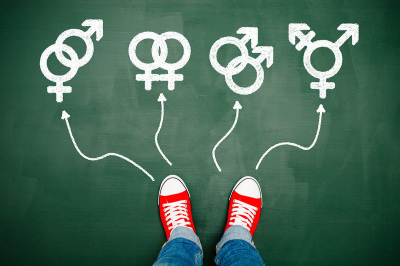Not trans, but just gay or lesbian?

Recently, The New York Times published an opinion column describing stories of people who, we’ve long been told, don’t exist. According to transgender activists and their allies in media, those who “detransition” are either legends or are so rare that they’re viewed as right-wing pawns and talking points. They have also been described as people with “a lot of internalized transphobia.” At best, they are viewed with suspicion because they complicate the narrative that “gender-affirming care” — a phrase that actually refers to social, chemical, and surgical rejections of biology — will bring peace and contentment with one’s true identity.
Because more than a few articles and opinion pieces in The New York Times have been critical of the idea of “detransitioners,” many were surprised at this opinion piece that compassionately told of individuals who detransitioned and highlighted the harms they faced from counselors, psychologists, and medical institutions.
Yet, though the piece comes off as a kind of exposé, it’s billed as an opinion piece. It largely repeated points made for years by scholars like Ryan Anderson, Abigail Shrier, and others. The irreversible harms of “gender-affirming care” have been known for some time. For example, we’ve long known that there’s a difference between gender dysphoria — which, historically, affected a very small population of young boys — and the rapid onset gender dysphoria of the last decade that affected skyrocketing rates of teen and pre-teen girls. We’ve known that major pediatric, psychiatric, and psychological associations were so captured by gender ideology that they preempted normal standards of care, rushed children to life-altering treatments, and refused to consider comorbidities like OCD, depression, autism, trauma, sexual abuse, and other physical and mental health issues. We’ve known that parents are often blackmailed with the threat of suicide of their child. We’ve also known that it is because of these factors that countries like France, Sweden, Norway, the Netherlands, and the U.K. have dramatically limited or eliminated the chemical and surgical transition of minors.
Perhaps most surprising, the Times published this opinion piece even though it contained a critique of activist organizations GLAAD and the Human Rights Campaign, accusing them of “suppressing” the language of rapid onset gender dysphoria. The author even pointed to the idea of gender confusion as a social contagion, noting that some “children were introduced to transgender influencers on YouTube or TikTok, a phenomenon intensified for some by the isolation and online cocoon of COVID.”
While it’s welcome to see a crack in a dangerous narrative that’s gone unquestioned for so long, the piece presented an increasingly common argument, one just as problematic as the one it counters. The author suggested that many who struggle with gender identity are, in reality, gay or lesbian, not trans. For example, the piece quoted Paul Garcia-Ryan, someone who recently detransitioned, as saying “it was much less threatening to my psyche to think that I was a straight girl born into the wrong body” than to admit he was attracted to the same sex. Several interviewees claimed that so-called “gender-affirming care” is just another form of so-called “conversion therapy,” the name given to any attempt to change someone’s sexual orientation.
However, this only substitutes one false understanding of identity with another. It also repeats the “born this way” argument that was used to normalize homosexuality, an argument that has been widely discredited. The “T’s” and the “Q’s” largely rejected that argument because it undermined their own claims about identity being so fluid. Still, most troubling is that this argument imposes a different bad idea about identity on children, reducing them to their sexual urges, and teaching them to reject, in a different way, one of the fundamental God-given purposes of the body.
Of course, someone who is wrestling with gender dysphoria may also struggle with same-sex attraction. In fact, that could even be the bigger struggle that they are facing. At the root of both conditions, however, is confusion about their true identity, including what it means for them to be human as male or female. Healing and wholeness will not be found by unqualifiedly “affirming” a confusion, whether about bodily changes or romantic attraction.
It is damnable to take advantage of the confusions of this particular developmental season, especially given the current grooming of same-sex romance in advertisements, movies, and television. It is a way of committing the same error of “gender-affirming care” by, to borrow the words of Paul Garcia-Ryan, “implementing a psychological intervention that narrows a person’s sense of self and closes off their options for considering what’s possible for them.”
The gay and lesbian movements did that far before the transgender movement.
Though distinct, transgenderism and homosexuality each reject the role biological sex plays in who we are and how we should live. Transgenderism denies that biological sex defines the true self.
Homosexuality rejects that sex defines who one should marry and engage in sexual intimacy with. Gender dysphoria and same-sex attraction are real burdens for some. But healing and wholeness will only be found in embracing, not rejecting, who God made us to be.
To learn more about identity from a Christian worldview, check out identityproject.tv. The Identity Project is the most comprehensive library available of on-demand videos and resources addressing issues of identity, the image of God as male and female, marriage, family, chastity, and sexual wholeness. For a special discount this month, go to identityproject.tv and enter BREAKPOINT at checkout.
Originally published at BreakPoint.
John Stonestreet serves as president of the Colson Center for Christian Worldview. He’s a sought-after author and speaker on areas of faith and culture, theology, worldview, education and apologetics.
Jared Hayden (M.A., Religion) is a Breakpoint contributor at the Colson Center for Christian Worldview. He is a graduate of Westminster Theological Seminary in Philadelphia where he studied Reformed theology, ethics, and theology of the body. A former researcher at the Heritage Foundation, he has focused his work on social policy and cultural analysis with a special interest in the intersection of gender and tech. His writing has appeared in National Review, The Federalist, and The American Conservative. More of Jared's personal research and writing can be found on his Substack Perishable Goods.
When he's not writing, Jared enjoys rock climbing, designing books, hosting dinners, and spending time with his niece and nephews.



























